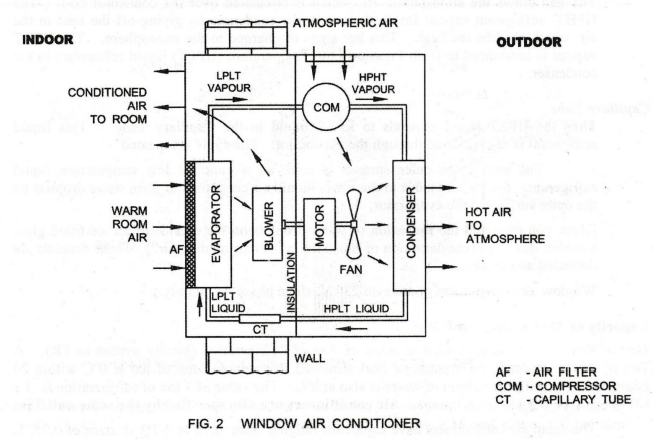Basic Civil & Mechanical Engineering: UNIT V: c. Air Conditioning
Window air conditioner or room air conditioner
Working Principal, Description, Layout Diagram, Advantages, Disadvantages
Window Air Conditioner is designed to condition the air in a single room and is hence known as Room Air Conditioner.
WINDOW AIR CONDITIONER or ROOM AIR CONDITIONER

As
the name implies, all the components of an Air Conditioner are assembled inside
a casing installed in the window of a
room at the window sill level. Hence, it is called Window Air Conditioner.
Fig. 1 shows the pictorial view of a window air conditioner.
Window
Air Conditioner is designed to condition the air in a single room and is hence
known as Room Air Conditioner.
Description
See Fig. 2. The window air conditioner
consists of a Vapour Compression Refrigeration System, Air Filter, Double Shaft
Motor, Centrifugal Blower and Propeller Type Fan. The vapour compression
refrigeration system consists of:
1.
Evaporator
2.
Compressor
3.
Condenser
4.
Expansion Valve in the form of a Capillary Tube
The
Evaporator part is facing the room (INDOOR). The Condenser part projects
outside the room (OUTDOOR). The evaporator part is insulated from the condenser
part. That is, the evaporator and condenser coils are separated by an Insulated
Partition to avoid the air movement between the room and atmosphere.
A
common Double Shaft Motor drives a Fan at one end and a Blower at the other
end. Adjustable Louvers continuously change the direction of air flow to ensure
uniform distribution of conditioned air inside the room.

Working Principle
Commonly used refrigerants are: Freon-12 and
Freon-22.
Evaporator
Evaporator
is a cooling coil made of copper. The Centrifugal Blower is instalied behind
the evaporator.
The
Blower sucks warm air from the room and sends it to the evaporator through the
Air Filter. [Air filter cleans the air by removing dust and dirt particles.]
The Low Pressure Low Temperature (LPLT) refrigerant inside the evaporator coil
absorbs the heat from the room air and evaporates. Therefore, the room air is
cooled as well as dehumidified by continuous heat removal. The
dehumidified-cooled air is blown back into the room.
The
desired temperature of 20°C to 25°C in the room for human body comfort is
maintained using the Control Panel.
Compressor
The
LPLT evaporated refrigerant is drawn by the suction of the Compressor.
compressor compresses it to High Pressure High Temperature (HPHT) vapour.
vapour flows into the Condenser Coil.
Condenser
The
Fan draws the atmospheric air, which is circulated over the condenser coil. The
HPHT refrigerant vapour inside the condenser condenses by giving-off the heat
to the air, which absorbs the heat. This hot air is discharged to the
atmosphere. The HPHT vapour is condensed to High Pressure Low Temperature
(HPLT) liquid refrigerant in the condenser.
Capillary Tube
Then
the HPLT liquid expands to LPLT liquid in the Capillary Tube. This liquid
refrigerant is re-circulated through the evaporator. The cycle is repeated.
The evaporator outer surface is cold, as it
contains low temperature liquid refrigerant. So, water vapour in the warm humid
air condenses to form water droplets on the outer surface of the evaporator.
[Have
you observed the formation of water droplets on the outside of an ice-filled
glass tumbler, due to the condensation of moisture in the surrounding air?]
These droplets are collected and drained.
Window air conditioners operate on 230 V,
singe phase AC supply.
Capacity of Air Conditioner
Unit of Refrigeration is expressed in terms of
Ton of Refrigeration (briefly written as TR). A Ton of Refrigeration is the
amount of heat absorbed to produce 1 ton of ice at 0°C within 24 hours when the
initial condition of water is also at 0°C. The value of 1 ton of refrigeration
is 3.5 kJ / second or 3.5 kW in S.I. units. Air conditioners are also specified by the same unit TR.
The
room air conditioners have capacities ranging from 0.75 to 4 TR in sizes of
0.75, 1, 1.5, 1.6, 2, 3 and 4 TR.
1. ADVANTAGES
1. Self-Contained Unit:
Window air conditioner is a self-contained single-package unit.
2.
For more than one room in a residential building, several window units can be
used. A separate temperature control is provided in each room in which the unit
is installed.
3. No Ducks: Ducts are not required for air
distribution. This advantage is especially noticeable in residences in mild
climates where central heating systems are not required.
4. Installation: Installation is simple and
plumbing is not required.
2. DISADVANTAGES
1.
Suitability: Not suitable for large halls and applications where heat and
moisture loads are high.
2.
Air Circulation: The unit has circulation of a fixed air quantity.
3.
Installation Constrain: The installation must be made only on an external wall
of the room.
Basic Civil & Mechanical Engineering: UNIT V: c. Air Conditioning : Tag: : Working Principal, Description, Layout Diagram, Advantages, Disadvantages - Window air conditioner or room air conditioner
Related Topics
Related Subjects
Basic Civil and Mechanical Engineering
BE3255 2nd Semester 2021 Regulation | 2nd Semester EEE Dept 2021 Regulation
